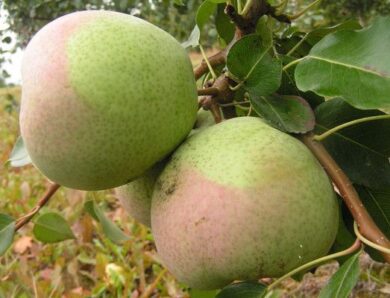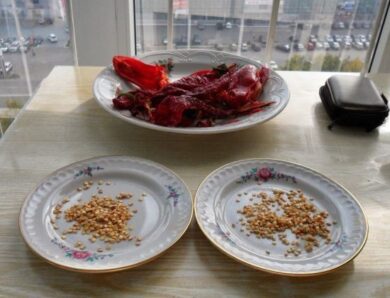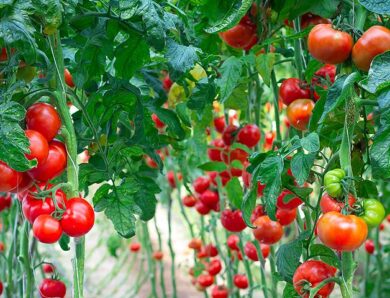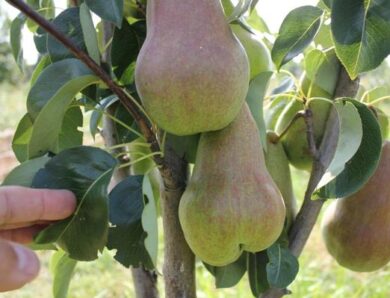Twisting leaves of tomatoes in a greenhouse: causes of pathology
When growing plants, people can face a variety of problems at any stage. Even after a responsible transplant of seedlings and successful rooting is one of the problems, which may occur - twisted tomato leaves in the greenhouse. This phenomenon can be caused by various reasons. To find out, why the leaves are twisted, you need to conduct a detailed inspection of the plant. After accurately determining the causes, you can do medical procedures and rehabilitate the plant.
Adverse conditions
These include very high air temperatures. Critical rate for tomatoes - 35 degrees of heat. This is one of the first reasons, why twisting occurs. To accurately determine the need to monitor the condition of the leaves at different times of the day. If in the evening they straighten out, then the reason is exactly in the temperature. Frequent ventilation should be provided to correct the situation. To prevent a recurrence of the problem, sun protection should be provided with lutrasil or other nonwovens.
Urea solution is sprayed on the tops to quickly correct the situation and relieve stress on the plants. To do this, dissolve one or one and a half tablespoons of the drug 10 And water. But planting should be treated only in the evening or in cloudy weather. You can fix the result in a few days with a solution of manganese, diluted to a faint pink state.

Diseases
One of the reasons for the twisting of the leaves at the top of the bush may be disease. Tomatoes are affected by such diseases:
- tobacco mosaic virus;
- fusarium wilt;
- bacterial cancer;
- verticillary.
Different methods and solutions are used for treatment, which have a health effect on the bush and the fruits on it. Some microorganisms, which is the cause of diseases are able to remain in the soil and affect the next crop. That is why the treatment of plants should be approached with responsibility and diligence.
Watering
Tomatoes react very painfully to too abundant watering, and for lack of moisture. With plenty of water, the roots of the plant can rot. If insufficient watering, you will see leaflets, which twisted in the form of a shuttle. So., the plant needs to be saved. However, do not overdo it. It is better to water the soil moderately and loosen it. It is recommended to water no more than once a week.
Fertilizers
Why the disadvantage, and excess minerals affect plant health? Tomatoes are quite a demanding crop. They can also react negatively to the lack of minerals in the soil, and their excess.
Examples of large amounts of fertilizer:
- Humus. Fresh manure or badly roasted humus has the ability to form a large dose of ammonia in the soil, which has a bad effect on tomatoes. It can even cause leaf burns, as well as fruit damage.
- Nitrogen. Poisons the soil in large quantities. As a result - twisting of leaves, as well as the appearance of powerful shoulder straps and thickening of the stem. This situation must be combated, for which kiln or other ash is used. Just one glass of this substance, dissolved in water, able to saturate the soil with phosphorus, potassium and other essential trace elements for plants. A mixture of will also help in such a problem 1 h. l. potassium monophosphate and 10 And water. By this means, it is recommended to treat each tomato bush. Otherwise, the root system of the plant will not be able to absorb the necessary zinc, potassium and phosphorus.
- Zinc. Excess zinc in the soil affects the old leaves. At the same time they are painted in purple along the trajectory from the edges to the center.
- Bor. Excess boron, as well as its disadvantage, affects the same - the middle leaves turn yellow, while the veins become purple.
Absence or lack of elements, which affect the twisting of leaves:
- Potassium deficiency - manifested in the change of color of the sheets to brown, changing the color of the veins to yellow, as well as twisting the leaves.
- Lack of phosphorus - the leaves are not only twisted, but also become greenish-gray. The veins are highlighted in red-purple color.
- Lack of zinc and sulfur - causes deformation of the leaf cover of tomatoes.
- Lack of copper - provokes the twisting of newly appeared leaves (the tops of the bush) to the middle veins.
In case of lack of any element it is necessary to do root or foliar feeding. If you do not, then the next stage of the deficit will be in the form of yellow, and later blackened spots.
Pests
Greenhouse plants are often susceptible to pests. Who they are and why it is important to fight them?
To organisms, which can affect the deformation of tomato leaves, include:
- greenhouse whitefly;
- spider mite;
- aphids, etc.
With the advent of such small enemies, the leaves of tomatoes curl up. To choose a way to fight, you need to recognize the enemy and try to find out, why and where it came from. To do this, take a young leaf, and carefully examine it from below.
If you notice little white flies (whiteflies), it is necessary to do processing by special means or to resort to the help of traps-baits. Black aphids are very difficult to spot. But you have to try, as it eventually passes from the leaves to the stem and stem. These insects saturate the plant with the substance, which causes twisting of the leaves. There will also be an insecticide.
Video "Why do leaves curl in tomatoes"
This video is about the reasons for twisting tomato leaves, as well as ways to combat this phenomenon.




